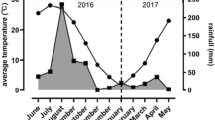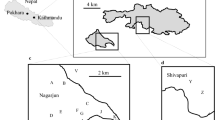Abstract
Comparative studies of sympatric species are essential in understanding those species’ behavioral and ecological adaptations as well as the mechanisms that can reduce resource competition enough to allow coexistence. We collected data on diet, activity budget and habitat use from two sympatric macaque species, the Assamese macaque (Macaca assamensis) and the rhesus macaque (M. mulatta), in a limestone seasonal rainforest of Nonggang Nature Reserve, southwestern Guangxi, China. Our results show that the two sympatric macaques differ in diet, activity budget, and habitat use: (1) out of the 131 plant species that were used by both macaque species as food over the year, only 15 plant species (11 %) were shared. Rhesus macaques used more plant species as major foods, and had higher dietary diversity and evenness indexes than Assamese macaques. (2) Assamese macaques fed predominantly on leaves, whereas rhesus macaques fed more selectively on fruits. The rhesus macaques’ diet varied according to season, and was significantly correlated to season fluctuation in fruit availability. (3) Assamese macaques devoted more time to resting, and less time to feeding than rhesus macaques (4) Assamese macaques were present mostly on the cliff, and tended to stay on the ground, whereas rhesus macaques were present mostly on the hillside, and showed preference to lower and middle canopy. The observed differences in diet and habitat use between the two macaque species represent behavioral patterns enabling their coexistence.







Similar content being viewed by others
References
Ahsan MF (1994) Feeding ecology of the primates of Bangladesh. In: Thierry B, Anderson RJ, Roeder JJ, Herrenschmidt N (eds) Current primatology. vol. Ecology and evolution. University of Louis Pasteur, Strasbourg, pp 79–86
Altmann J (1974) Observational study of behavior: sampling methods. Behaviour 49:227–262
Bennett EL, Davies AG (1994) The ecology of Asian colobines. In: Davies AG, Oates JF (eds) Colobine monkeys: their ecology, behavior and evolution. Cambridge University Press, Cambridge, pp 129–171
Britt A, Randriamandratonirina NJ, Glasscock KD, Iambana BR (2002) Diet and feeding behaviour of Indri indri in a low-altitude rain forest. Folia Primatol 73:225–239
Chalise MK (2003) Assamese macaques (Macaca assamensis) in Nepal. Primate Conserv 19:99–107
Chapman CA, Pavelka MSM (2005) Group size in folivorous primates: ecological constraints and possible influence of social factors. Primates 46:1–9
Chivers DJ, Hladik CM (1980) Morphology of the gastrointestinal tract in primates: comparisons with other mammals in relation to diet. J Morphol 166:337–386
Cords M (1986) Interspecific and intraspecific variation in diet of two forest guenons, Cercopithecus ascanius and C. mitis. J Anim Ecol 55:811–827
Feeroz MM (2012) Niche separation between sympatric pig-tailed macaque (Macaca leonina) and rhesus macaque (M. mulatta) in Bangladesh. J Primatol 1:106
Fooden J (1980) Classification and distribution of living macaques. In: Lindburg DG (ed) The macaques: studies in ecology, behavior and evolution. Van Nostrand Reinhold, New York, pp 1–9
Ganzhorn JU (1989) Niche separation of seven lemur species in the eastern rainforest of Madagascar. Oecologia 79:279–286
Gause G (1934) The struggle for existence. Williams and Witkins, Baltimore
Goldstein SJ, Richard AF (1989) Ecology of rhesus macaques (Macaca mulatta) in northwest Pakistan. Int J Primatol 10:531–567
Guangxi Forest Department (1993) Nature reserve in Guangxi. China Forestry Publishing House, Beijing (in Chinese)
Hadi S, Ziegler T, Waltert M, Syamsuri F, Mühlenberg M, Hodges JK (2012) Habitat use and trophic niche overlap of two sympatric colobines, Presbytis potenziani and Simias concolor, on Siberut Island, Indonesia. Int J Primatol 33:218–232
Hanya G, Ménard N, Qarro M, Tattou MI, Fuse M, Vallet D, Yamada A, Go M, Takafumi H, Tsujino R, Agetsuma N, Wada K (2011) Dietary adaptations of temperate primates: comparisons of Japanese and Barbary macaques. Primates 52:187–198
Kummar RS, Mishra C, Sinha A (2007) Foraging ecology and time activity budgets of the Arunachal macaque Macaca munzala, a preliminary study. Curr Sci 93:532–539
Lambert JE (1998) Primate digestion: interactions among anatomy, physiology, and feeding ecology. Evol Anthropol 7:8–20
Liang ZF, Liang JY, Liu LF, Mo XL (1988) A report on vegetation in Nonggang Nature Reserve. Guihaia (Supplement 1): 83–184 (in Chinese)
MacKinnon J, MacKinnon K (1980) Niche differentiation in a primate community. In: Chivers D (ed) Malayan forest primates. Plenum Press, New York, pp 167–190
Nadjafzadeh MN, Heymann EW (2008) Prey foraging of red titi monkeys, Callicebus cupreus, in comparison to sympatric tamarins, Saguinus mystax and Saguinus fuscicollis. Am J Phys Anthropol 135:56–63
Nakagawa N (1999) Differential habitat utilization by patas monkeys (Erythrocebus patas) and tantalus monkeys (Cercopithecus aethiops tantalus) living sympatrically in northern Cameroon. Am J Primatol 49:243–264
Nakagawa N (2003) Difference in food selection between patas monkeys (Erythrocebus patas) and tantalus monkeys (Cercopithecus aethiops tantalus) in Kala Maloue National Park, Cameroon, in relation to nutrient content. Primates 44:3–11
Pianka ER (1973) The structure of lizard communities. Ann Rev Ecol Syst 4:53–74
Pianka ER (1981) Competition and niche theory. In: May R (ed) Theoretical ecology: principles and applications. Blackwell Scientific Publications, Oxford, pp 167–196
Porter LM (2001) Dietary differences among sympatric Callitrichinae in northern Bolivia: Callimico goeldii, Saguinus fuscicollis and S. labiatus. Int J Primatol 22:961–992
Powzyk JA, Mowry CB (2003) Dietary and feeding differences between sympatric Propithecus diadema diadema and Indri indri. Int J Primatol 24:1143–1162
Pyke GH, Pulliam HR, Charnov EL (1977) Optimal foraging: a selective review of theory and tests. Quart Rev Biol 52:137–157
Richard AF (1985) Primates in nature. W.H. Freeman, New York
Richard AF, Goldstein SJ, Dewar RE (1989) Weed macaques: the evolutionary implications of macaque feeding ecology. Int J Primatol 10:569–594
Rodman PS (1991) Structural differentiation of microhabitats of sympatric macaca fascicularis and M. nemestrina in east Kalimantan, Indonsia. Int J Primaol 12:357–375
Schoener T (1974) Resource partitioning in ecological communities. Science 185:27–39
Schreier BM, Harcourt AH, Coppeto SA, Somi MF (2009) Interspecific competition and niche separation in primates: a global analysis. Biotropica 41:283–291
Shu ZM, Zhao TL, Huang QC (1988) Vegetation survey in Nonggang Nature Reserve. Guihaia (Supplement 1): 185–214 (in Chinese)
Singh M, Roy K, Singh M (2011) Resource partitioning in sympatric langurs and macaques in tropical rainforests of the central western Ghats, south India. Am J Primatol 73:335–346
Smith RJ, Jungers WL (1997) Body mass in comparative primatology. J Hum Evol 32:523–559
Stevenson PR, Quinones MJ, Ahumada JA (2000) Influence of fruit availability on ecological overlap among four neotropical primates at Tinigua National Park, Colombia. Biotropica 32:533–544
Su HH, Lee LL (2001) Food habits of Formosan rock macaques (Macaca cyclopis) in Jentse, northeastern Taiwan, assessed by fecal analysis and behavioral observation. Int J Primatol 22:359–377
Sushma HS, Singh M (2006) Resource partitioning and interspecific interactions among sympatric rainforest arboreal mammals of the Western Ghats, India. Behav Ecol 17:479–490
Tang HX, Zhou QH, Huang ZH, Meng YJ, Huang CM (2011) Activity patterns and time budgets of the rhesus macaque in karst habitat. Chin J Zool 46(2):32–38 (in Chinese)
Tokeshi M (1999) Species coexistence: ecological and evolutionary perspectives. Blackwell Scientific Publications, Oxford
Tomblin D, Cranford J (1994) Ecological niche differences between Alouatta palliate and Cebus capucinus comparing feeding modes, branch use and diet. Primates 33:265–274
Tutin CEG, Fernandez M (1993) Composition of the diet of chimpanzees and comparisons with that of sympatric lowland gorillas in the Lopé Reserve, Gabon. Am J Primatol 30:195–211
Zhang RZ, Cheng LW, Qu WY, Chris C (2002) The primates of China: biogeography and conservation status: past, present and future. China Forestry Publishing House, Beijing (in Chinese)
Zhou QH, Wei H, Huang ZH, Li YB, Lu MX, Huang CM (2007) Activity patterns and time budgets of the Assamese macaque Macaca assamensis in the Longgang Nature Reserve, China. Acta Zool Sin 53(5):791–799 (in Chinese)
Acknowledgments
This study was supported by National Nature Science Foundation of China (No. 31172122, 31360093, 31372145), Guangxi Nature Science Foundation (2012GXNSFAA053039, 2012GXNSFBA053045), Guangxi Key Laboratory of Rare and Endangered Animal Ecology, Guangxi Normal University (1301z003), and the Assessment, Monitoring and Conservation of Tibetan macaques Project of the National Forestry Administration of China. We thank the Guangxi Forestry Bureau, and Nonggang National Nature Reserve.
Author information
Authors and Affiliations
Corresponding author
About this article
Cite this article
Zhou, Q., Wei, H., Tang, H. et al. Niche separation of sympatric macaques, Macaca assamensis and M. mulatta, in limestone habitats of Nonggang, China. Primates 55, 125–137 (2014). https://doi.org/10.1007/s10329-013-0385-z
Received:
Accepted:
Published:
Issue Date:
DOI: https://doi.org/10.1007/s10329-013-0385-z




